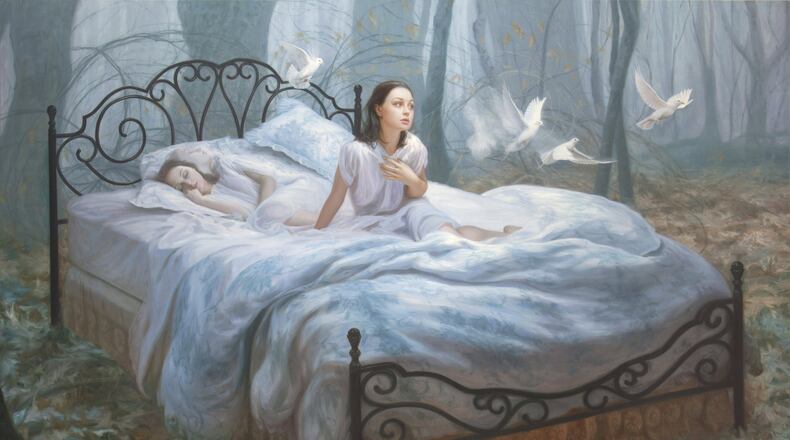ART REVIEW
“The Painted Figure”
Through Nov. 18. 10 a.m.-5 p.m. Mondays-Fridays; 11 a.m.-5 p.m. Saturdays. Free. Tew Galleries, 425 Peachtree Hills Ave. N.E., #24, Atlanta. 404-869-0511, www.tewgalleries.com.
Bottom line: Painting fans of every stripe will surely find something to love in this diverse group show.
In a month dominated by photography as Atlanta Celebrates Photography blankets the city with artwork and lectures, "The Painted Figure" at Tew Galleries is a reminder of the power of paint.
Featuring four artists who tackle painting from utterly different angles, “The Painted Figure” teams up heady Canadian artist Paul Fenniak, Atlanta’s own purveyor of quirk Charles Keiger, Spain’s delightful imp of oil Mario Soria and the atmospheric odes to beauty from Pennsylvania artist Dorian Vallejo.
The brightly wrapped surprise in the show is Barcelona artist Soria, whose combination of gobsmacking technique and imagination may make him the star of this four-person painting show. Dripping charm, Soria’s puckish, nutty subject matter and his enchanting tomfoolery with our expectations unleash spasms of delight.
Canadian artist Fenniak creates the kind of dappled, hazy images that can look like the covers of contemporary novels about urbanites in existential crisis. His frazzled city folk stand on rooftops holding extension cords, the city’s hodgepodge skyline of apartment buildings and cathedrals laid out behind them.
Potent little short stories about ambiguous circumstances dominate in works like “Parachutist” of a man in weekendy leisure wear fishing a parachute out of a storm drainage ditch. In “Man With Collapsible Umbrella,” another fellow holds his deflated umbrella like a Glock overhead as he enters a church for some kind of refuge, either spiritual or weather-related, his other hand gripping what could be the entrance to a confession booth.
Admittedly influenced by European art house and independent cinema from Carl Dreyer to Werner Herzog, Fenniak’s intriguing paintings plumb, in his words, “the mystery of another’s life.”
If Fenniak’s paintings suggest the complicated moral universe of contemporary fiction, then Vallejo’s epic paintings, with their glossy surfaces and beautiful women plunging through space in gossamer dresses, or caught in a reverie between wakefulness and dream in “Awakening,” their bedrooms invaded by trees and a blanket of leaves, suggest the contours of a moody romance. Vallejo’s dreamy heroines are exquisitely rendered in shades of blue and gray; ethereal studies in surface beauty.
Keiger, a longtime Tew artist, conjures up a number of associations in his highly imaginative, cheeky paintings of prize cattle, circuses and carnivals, cowboys and country singers, showmen and hucksters. His works mash up Americana-inflected surrealism and references to old school oil painting from Rousseau to Magritte with their frozen tableaux and theatrical prosceniums.
Keiger meets up with his kindred spirit in the second-floor gallery space where Soria works a similar strain of old world Spanish painting and new jack pop culture. In his “Infanta Galactica,” a Velazquez-inspired Maria Theresa in fancy garb collides with anachronistic characters out of “Toy Story” and “The Jetsons,” who hover above her head like time-traveling gnats. Delightfully off-kilter and prone to play around with the usual painterly parameters, Soria doodles onto the frame of his drawings and paintings, or introduces tiny plastic Barbie shoes or a miniature fisherman in a boat dangling a line onto the picture plane to take his work into the third dimension.
In the gorgeously rendered painting “Madame Pinochio” of a woman in 16th-century garb with a long nose, painted in rich, glistening colors, the entire frame is encrusted with toys: dice and dolls, Legos and animals, all dipped in slick gold. The forms glued to the frame cast gooey, dripping shadows on the portrait and in a characteristic technique, Soria leaves fat gobs of paint clinging to his painting surface, as if cleverly, winkingly acknowledging the act of painting itself.
About the Author
Keep Reading
The Latest
Featured


